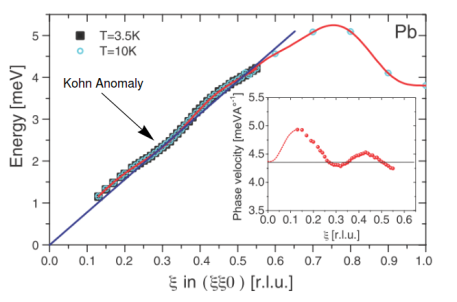Kohn anomalies are dips in phonon dispersions that arise because of the presence of a Fermi surface. The presence of the Fermi surface renormalizes the bare phonon frequencies and causes an anomly in the phonon dispersion, as seen below for lead (taken from this paper):
Why this happens can be understood using a simplified physical picture. One can imagine that the ions form some sort of ionic plasma in the long-wavelength limit and we can use the classical harmonic oscillator equation of motion:
One can take into account the screening effect of the electrons by including an electronic dielectric function:
The phonon frequencies will therefore be renormalized like so:
and the derivative in the phonon frequency will have the form:
.
Therefore, any singularities that arise in the derivative of the dielectric function will also show up in the phonon spectra. It is known (using the Lindhard function) that there exists such a weak logarithmic singularity that shows up in 3D metals at . This can be understood by noting that the ability of the electrons to screen the ions changes suddenly due to the change in the number of electron-hole pairs that can be generated below and above
.
The dip in the phonon dispersion can be thought of as the phonon analogue of the “kinks” that are often seen in the electron dispersion relations using ARPES (e.g. see here). In the case here, the phonon dispersion is affected by the presence of the electrons, whereas in the “kink” case, the electronic dispersion is affected by the presence of the phonons (though kinks can arise for other reasons as well).
What is remarkable about all this is that before the advent of high-resolution ARPES, it was difficult to map out the Fermi surfaces of many metals (and still is for samples that don’t cleave well!). The usual method was to use quantum oscillations measurements. However, the group in this paper from the 60s actually tried to map out the Fermi surface of lead using just the Kohn anomalies! They also did it for aluminum. In both cases, they observed pretty good agreement with quantum oscillation measurements — quite a feat!

thanks, it’s very helpful to me
LikeLike
Well, that’s the simplest and easy explanation to Kohn anomalies.
Nice work!
LikeLike